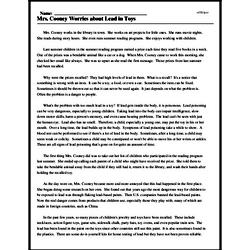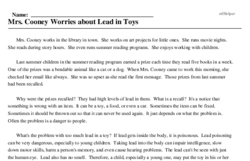Mrs. Cooney Worries about Lead in Toys
Mrs. Cooney works in the library in town. She works on art projects for little ones. She runs movie nights. She reads during story hours. She even runs summer reading programs. She enjoys working with children.
Last summer children in the summer reading program earned a prize each time they read five books in a week. One of the prizes was a bendable animal like a cat or a dog. When Mrs. Cooney came to work this morning, she checked her email like always. She was so upset as she read the first message. Those prizes from last summer had been recalled.
Why were the prizes recalled? They had high levels of lead in them. What is a recall? It's a notice that something is wrong with an item. It can be a toy, a food, or even a car. Sometimes the item can be fixed. Sometimes it should be thrown out so that it can never be used again. It just depends on what the problem is. Often the problem is a danger to people.
What's the problem with too much lead in a toy? If lead gets inside the body, it is poisonous. Lead poisoning can be very dangerous, especially to young children. Taking lead into the body can impair intelligence, slow down motor skills, harm a person's memory, and even cause hearing problems. The lead can't be seen with just the human eye. Lead also has no smell. Therefore, a child, especially a young one, may put the toy in his or her mouth. Over a long time, the lead builds up in the body. Symptoms of lead poisoning take a while to show. A blood test can be performed to see if there's a lot of lead in the body. Sometimes, after a long time, a child may seem weak or colicky. Sometimes a child may be constipated or won't be able to move his or her wrists or ankles. These are all signs of lead poisoning that's gone on for quite an amount of time.




